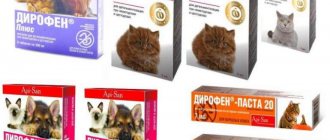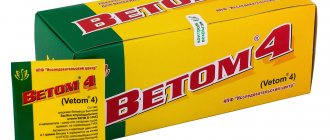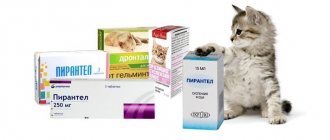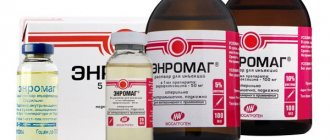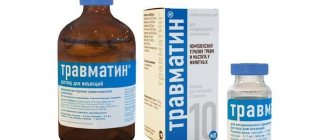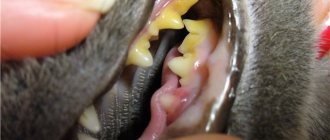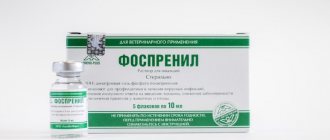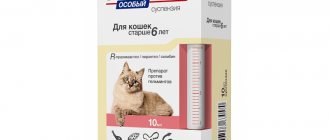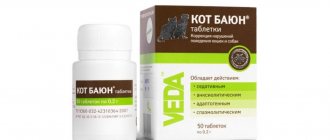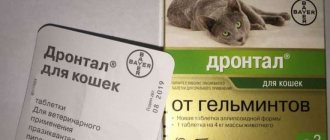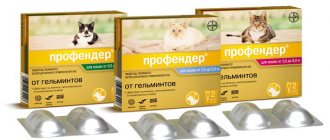- VetConsultPlus
- Informational portal
- Veterinary drug
- Trade name of the drug: Dirofen
- Latin name: Dirophen tabulettae
- Drug group: anthelmintic
- Active ingredients: febantel, pyrantel and praziquantel.
- Dosage form: tablets for oral use.
- Dirofen tablets are produced in three dosages: 120 mg for kittens, 200 mg for cats and small dogs, and 1000 mg each for large dogs.
Compound:
in 1 tablet as active ingredients - febantel - 15 mg, 75 mg, 300 mg; pyrantel - 15 mg, 75 mg, 300 mg; praziquantel - 5 mg, 25 mg, 100 mg and excipients: lactose, calcium stearate, silicon dioxide, talc, cellulose.
Appearance: flat, round, light yellow tablets with two perpendicularly spaced dividing grooves on one side.
The shelf life of the drug, subject to storage conditions, is 3 years from the date of production. Target species: cats and dogs. Do not use Dirofen in cats after the expiration date.
Name and address of the production site of the manufacturer of the medicinal product for veterinary use: LLC NPO "Api-San", Moscow region, Balashikha, Poltevskoe highway, possession 4.
General information
According to the instructions, 1 tablet of Dirofen (120 mg, 200 mg and 1000 mg) contains the following active ingredients:
- febantel - 15 mg, 75 mg, 300 mg, respectively
- pyrantel - 15 mg, 75 mg, 300 mg, respectively
- praziquantel - 5 mg, 25 mg, 100 mg, respectively
- excipients: lactose, calcium stearate, silicon dioxide, talc, cellulose
Dirofen for cats is produced packaged in 6 tablets in strips made of laminated paper or in jars made of polymer material with lids with first-opening control and packaged individually in cardboard boxes complete with instructions for use.
Store Dirofen tablets for kittens and cats in the manufacturer's sealed packaging, in a place protected from direct sunlight, separately from food and feed at a temperature of 0 °C to 25 °C.
Dirofen should be stored out of the reach of children. According to the instructions for use, unused drug is disposed of in accordance with legal requirements. Conditions of release: without a veterinarian's prescription.
Application procedure
Before using Dirofen for the treatment or prevention of helminthiasis in cats, you should consult a veterinarian and also study the instructions for use. This will help speed up healing or prevent infection, as well as avoid complications during therapy.
Dirofen can be given to cats from the age of 3 weeks.
The tablets are taken orally (by mouth). No special preparation is required before taking the medicine. The cat should not fast or take laxatives. Dirofen is given in the morning before meals. It is recommended to hide the tablet in a small amount of regular food. You can put it in whole or pre-chop it so that the cat doesn’t notice.
Sometimes owners are unable to get the animal to take the medicine. In this case, you should resort to the following techniques:
- insert the pill into the cat's throat;
- use an introducer (a device for safely administering tablets and capsules to cats);
- A whole or crushed tablet can be hidden in sausage, minced meat and other cat favorite food.
The dose of the drug depends on the amount of active components and the cat’s body weight:
- the dosage of Dirofen 120 mg is calculated using the following formula - 1 tablet/1 kg of the pet’s total weight;
- tablets 200 mg – 1 pill/5 kg.
It is strongly not recommended to increase the dose on your own. This is dangerous, it is better to give the animal a little less of the drug. But there should be no problems with dividing the tablet, since it is divided into 2-4 parts.
The treatment regimen depends on the diagnosis, type of infection, and the final goal. Cats are given Dirofen once to prevent infection, before vaccination or mating. Prevention is carried out once every 3 months.
Two-stage deworming is carried out in the following cases:
- to prevent infection in crowded conditions (in nurseries, shelters, vivariums);
- for helminthiasis, which is confirmed by laboratory tests.
In the latter case, the doctor must accurately determine the pathogen (nematodes, cestodes or combined infection).
Frequency of administration of Dirofen for various types of helminthiasis:
- if the cat’s body is affected by roundworms (nematodes) - twice with a 2-week break;
- for cestodosis or combined infection - 1 time per day for 3 days, after 2 weeks the same regimen is repeated (once for 3 days).
The therapeutic effect of Dirofen will be noticeable if the owner follows the dosage and treatment regimen.
Important! If the next dose of Dirofen is missed, the tablet is given to the cat as soon as possible. In this case, the dosage cannot be increased. The interval between doses in the future is also maintained.
Pharmacological properties of Dirofen
Dirofen for cats is classified as a combination anthelmintic drug.
The combination of praziquantel, febantel and pyrantel, which are part of Dirofen, provides a wide spectrum of its anthelmintic effect on all phases of the development of round and tapeworms parasitizing the gastrointestinal tract of cats:
- Alveococcus multilocularis
- Ancylostoma caninum
- Diphyllobothrium latum
- Dipylidium caninum
- Echinococcus granulosus
- Mesocestoides lineatus
- Multiceps multiceps
- Toxascaris leonina
- Trichuris vulpis
- Uncinaria stenocephala
- Tohosara mystax
- Tohosara canis
Indications for use
Dirofen helps cure and prevent helminthiasis in cats. This medicine is effective against the following worms:
- nematodes (roundworms) – toxocara, toxascaridae, hookworms, uncinaria, whipworms;
- cestodes (tapeworms) – echinococci, mesocystoids, bovine, pork, cucumber tapeworms, broad tapeworms.
The use of Dirofen for cats is advisable in the following cases:
- nematode infection;
- infestation by cestodes;
- mixed helminthiases.
The components of Dirofen negatively affect eggs, larvae, and mature parasites. They extend to many systems (including the central nervous system). The advantage of the drug is that after regular use, the worms remain sensitive to the anthelmintic substances. That is, parasites do not develop resistance to the components of the drug.
Praziquantel is the second active ingredient of Dirofen
Praziquantel is a compound of the pyrazinisoquinoline group, active against gastrointestinal cestodes at all phases of development. By increasing the permeability of the parasite's cell membranes to calcium ions, it causes depolarization of the membranes, muscle contraction and destruction of the tegument, which leads to the death of helminths and promotes their elimination from the cat's body. The compound is rapidly absorbed in the gastrointestinal tract, reaching a maximum concentration in the blood plasma after 1-3 hours, reversibly binds to serum proteins (70-80%), is partially metabolized in the liver in cats, is re-excreted into the intestines, and is mainly excreted from the body with urine (up to 80%) within 24 hours.
What are helminthiases?
Worm infestations are common in domestic dogs and cats - intestinal parasites are found even in pets that do not go outside and do not interact with other animals. Helminth eggs enter the gastrointestinal tract:
- on a walk - with street mud or water from puddles/street ponds;
- with food – raw fish/meat;
- upon contact with a sick animal;
- through intermediate hosts - ticks and fleas.
Common symptoms of helminthiasis are:
- causeless loss of appetite;
- digestive disorders - vomiting, diarrhea or constipation;
- bloating;
- decrease in body weight with a constant amount of food;
- lethargy, low physical activity;
- itching and rash in the anal area;
- difficulty swallowing, hiccups/cough;
- dull coat and excretion of helminths in feces.
These signs are nonspecific; the presence of parasites can only be confirmed by testing at a veterinary clinic.
Helminth infections are dangerous because they can:
- proceed without pronounced symptoms, “undermining” the health of an adult pet for a long time or disrupting the development of a puppy/kitten;
- give a clear clinical picture, making it difficult to identify other diseases.
“Unscheduled” destruction of existing parasites is necessary:
- 14 days before vaccination or surgery;
- when worms are detected in excrement;
- after eliminating fleas/ticks that carry helminth eggs;
- 90 days before mating (taking into account the expected date of vaccination).
Febantel is the third active ingredient of Dirofen
According to the instructions, febantel belongs to probenzimidazoles, which are biotransformed in the body into benzimidazoles. The mechanism of action of febantel is based on inhibition of the fumarate reductase enzyme in the mitochondria of helminths, as a result of which the absorption of glucose and the synthesis of the protein tubulin are disrupted, which leads to the destruction of the microtubular apparatus of the parasite cells, causing its death. Febantel is absorbed in the intestine, metabolized in the liver and excreted with bile into the intestinal lumen, where its repeated resorption is partially noted; it is excreted from the body of cats both in unchanged form and in the form of several metabolites in feces and urine.
According to GOST 12.1.007-76, dirofen for domestic cats, in terms of the degree of impact on the cat’s body, is classified as a low-hazard substance (hazard class 4), in recommended doses it does not have embryotoxic, teratogenic or sensitizing effects. The drug is well tolerated by dogs and cats of different breeds and ages.
Cost and analogues of Dirofen
The medicine is inexpensive. Its cost, depending on the dosage, ranges from 100 to 150 rubles.
Dirofen is an inexpensive drug
If the use of the drug is contraindicated for some reason, then its analogues are prescribed.
The main ones are:
- Prazicide;
- Drontal;
- Pyrantel;
- Febantel;
- Praziquantel;
- Profender.
Before using the analogue, it is recommended to consult a veterinarian.
Dosing of Dirofen for cats
Tablets for kittens - 1 tablet per 1 kg of animal weight;
Tablets for cats and dogs of small breeds - 1 tablet per 5 kg of animal weight
According to the instructions, in case of an overdose of Dirofen in cats
a depressed state, refusal to feed, excessive salivation, and gastrointestinal upset may occur. In these cases, general measures are used aimed at removing the drug from the body.
When using the drug for the first time in cats, self-limiting hypersalivation is possible.
For pregnant cats, Dirofen tablets are prescribed 3 weeks before the expected birth with caution, under the supervision of a veterinarian, for lactating females - 2-3 weeks after birth.
Violations of the deworming regimen for animals should be avoided, as this may lead to a decrease in effectiveness. If the next deworming is missed, the drug must be administered as soon as possible in the same dose, then the interval between administrations of the drug does not change.
When using Dirofen tablets in accordance with these instructions, side effects and complications in animals, as a rule, are not observed. Some animals may experience disturbances in the gastrointestinal tract (loose stools, vomiting) and increased salivation, which disappear spontaneously and do not require the use of medications.
Dirofen tablets should not be used concomitantly with piperazine and cholinesterase inhibitors.
According to the instructions for use in veterinary medicine, Dirofen tablets are not intended for use in productive animals.
Limitations and negative consequences
Dirofen is a safe anthelmintic drug, but it should not be given to animals that exhibit allergic reactions to one or more components of the drug, pregnant cats in the first half of pregnancy, and kittens under 4 weeks of age. The reasons for replacing the drug are:
- infectious diseases and the recovery period after them;
- exhaustion.
Important!
The drug has restrictions on combined use with anticholinesterase drugs and piperazine.
An overdose is fraught with unpleasant consequences, including:
- nausea and vomiting;
- refusal of food;
- depressed state;
- increased salivation;
- intestinal disorders.
If the dose is slightly exceeded, unpleasant symptoms may go away on their own; in case of a large overdose, it is necessary to contact a veterinary clinic for gastric lavage and special therapy.
Personal prevention measures
When working with Dirofen, you should follow the general rules of personal hygiene and safety precautions provided for when working with medications.
Smoking, drinking and eating are prohibited during work. When finished, wash your hands with warm water and soap. It is prohibited to use empty packaging of the drug for household purposes; it must be disposed of with household waste.
According to the instructions, in case of accidental contact of the drug with the skin or mucous membranes of the eyes, they must be rinsed with plenty of water. People with hypersensitivity to the components of the drug should avoid direct contact with Dirofen. If allergic reactions occur or if the drug accidentally enters the human body, you should immediately contact a medical facility (bring with you the instructions for use of the drug or the label).
Name, address of the organization authorized by the holder or owner of the registration certificate for the medicinal product Dirofen for cats and kittens to accept claims from the consumer: LLC NPO "Api-San", Moscow region, Balashikha, Poltevskoe highway, possession 4.
Advantages and disadvantages
The advantages of Dirofen include the following factors:
- convenient release forms (many drugs are available only in tablet form);
- convenient dosage (you can choose a modification that suits a specific cat);
- the tablet can be easily divided into 4 parts due to the risks;
- Possibility of use for pregnant, lactating cats and kittens;
- high degree of efficiency;
- reasonable price (suspension and paste 7 ml - from 150 rubles, tablets - from 25 rubles per piece).
But Dirofen also has disadvantages:
- there are contraindications;
- the anthelmintic does not have a pleasant taste (like some other drugs);
- not all pharmacies have the required form of the drug;
- there is a possibility of a side effect - increased salivation.
One of the advantages of the drug is that some pharmacies sell Dirofen tablets individually
Learn about essential antimicrobials in animals
- Trichopolum instructions for veterinary medicine
- Instructions for the use of the antibiotic Baytril in animals
- Instructions for use of metronide
- Instructions for ceftriaxone preparations for animals
- Use of Metrogyl in veterinary medicine
- Instructions for doxycycline in animals
- Metronidazole (Metronidazole) for animals (instructions for use in veterinary medicine, doses, indications and contraindications)
- Atovaquone (ATOVAQUONE)
- Azithromycin, instructions for animal therapy
^Top
Dirofen tablets for kittens and puppies 6 tablets 120 mg each
DESCRIPTION
Dirofen tablets (Dirophen tabulettae) are tablets for oral use for deworming for kittens and puppies. In appearance, the drug is a flat round tablet of light yellow color, with two perpendicularly located dividing grooves on one side. The company logo (AS) may be imprinted on the other side of the tablet.
COMPOUND
In 1 tablet the active ingredients are febantel 15 mg, pyrantel pamoate 15 mg, praziquantel 5 mg and excipients lactose, calcium stearate, colloidal silicon dioxide, talc, microcrystalline cellulose.
PHARMACOLOGICAL PROPERTIES
Dirofen tablets belong to combined anthelmintic drugs.
The combination of praziquantel, febantel and pyrantel pamoate, which are part of the drug, provides a wide spectrum of its anthelmintic effect on all phases of development of round and tape helminths parasitizing the gastrointestinal tract of dogs and cats, including Toxocara canis, Toxocara shystax, Toxascaris leonina, Uncinaria stenocephala, Trichuris vulpis, Ancylostosha caninshn, Echinococcus granulosus, Alveococcus multilocularis, Mesocestoides lineatus, Dipylidishn caninush, Diphyllobothriush latush, Multiceps shulticeps.
Pyrantel pamoate is a compound of the pyrimidine group, its mechanism of action is based on blocking the transmission of nerve impulses at neuromuscular synapses by depolarizing the membranes of muscle cells, which causes paralysis of the muscular system of nematodes; pyrantel is poorly absorbed, which ensures its prolonged effect on helminths in the intestines; excreted from the body mainly unchanged (93%) in feces.
Praziquantel, a compound of the pyrazinisoquinoline group, is active against gastrointestinal cestodes at all phases of development. By increasing the permeability of the parasite's cell membranes to calcium ions (Ca2+), it causes membrane depolarization, muscle contraction and tegument destruction, which leads to the death of helminths and promotes their elimination from the animal's body. The compound is rapidly absorbed in the gastrointestinal tract, reaching a maximum concentration in the blood plasma after 1-3 hours, reversibly binds to serum proteins (70-80%), is partially metabolized in the liver, re-excreted into the intestines, and excreted from the body mainly in the urine. (up to 80%) within 24 hours.
Febantel belongs to probenzimidazoles, which are biotransformed in the body into benzimidazoles. The mechanism of action of febantel is based on inhibition of the fumarate reductase enzyme in the mitochondria of helminths, as a result of which the absorption of glucose and the synthesis of the protein tubulin are disrupted, which leads to the destruction of the microtubular apparatus of the parasite cells, causing its death. Febantel is absorbed in the intestine, metabolized in the liver and excreted with bile into the intestinal lumen, where its repeated resorption is partially noted, and is excreted from the body both in unchanged form and in the form of several metabolites in feces and urine.
In terms of the degree of impact on the body, Dirofen tablets are classified as low-hazard substances (hazard class 4 according to GOST 12.1.007-76), in recommended doses they do not have embryotoxic, teratogenic or sensitizing effects, and are well tolerated by dogs and cats of different breeds and ages.
DOSAGE AND APPLICATION
Dirofen tablets are prescribed to kittens and puppies from 3 weeks of age for prophylactic and therapeutic purposes for nematodes (toxocariasis, toxascariasis, uncinariasis, trichuriasis, hookworm infection), cestodiasis (tenidosis, dipylidiasis, echinococcosis, diphyllobothriasis, mesocestoidosis) and associated nematodo-cestodiasis infestations x gastro- intestinal tract.
Dirofen® tablets for kittens and puppies - 1 tablet per 1 kg of animal weight.
Dirofen tablets are administered to animals individually, in the morning feeding with a small amount of food or treat. No preliminary fasting diet or use of laxatives is required.
For preventive purposes, deworming is carried out once, quarterly, and also before each vaccination.
For therapeutic purposes, as well as for the purpose of prevention in group (crowded) keeping of animals (kennels, shelters, vivariums), treatment is carried out: for nematodes - twice with an interval of 14 days; for cestodias and associated nematodo-cestodal infestations - twice with an interval of 14 days, once a day for 3 consecutive days.
SPECIAL INSTRUCTIONS
In case of an overdose of the drug, the animal may experience a depressed state, refusal to feed, excessive salivation, and gastrointestinal upset. In these cases, general measures are used aimed at removing the drug from the body.
When using the drug for the first time in cats, self-limiting hypersalivation is possible.
Violations of the deworming regimen for animals should be avoided, as this may lead to a decrease in effectiveness. If the next deworming is missed, the drug must be administered as soon as possible in the same dose, then the interval between administrations of the drug does not change.
Dirofen tablets should not be used concomitantly with piperazine and cholinesterase inhibitors.
Dirofen tablets are not intended for use in productive animals.
For pregnant females, the drug is prescribed 3 weeks before the expected birth with caution, under the supervision of a veterinarian, for lactating females - 2-3 weeks after birth.
CONTRAINDICATIONS
A contraindication for use is individual intolerance to the components of the drug (including a history of). Dirofen tablets should not be used by females in the first half of pregnancy, exhausted animals, patients with infectious diseases or convalescent animals.
SIDE EFFECTS
When using Dirofen tablets in accordance with these instructions, side effects and complications in animals, as a rule, are not observed. Some animals may experience disturbances in the gastrointestinal tract (loose stools, vomiting) and increased salivation, which disappear spontaneously and do not require the use of medications.
SHELF LIFE AND STORAGE
The shelf life of the drug, subject to storage conditions, is 3 years from the date of production. Do not use Dirofen tablets after the expiration date.
Store Dirofen tablets in the manufacturer's sealed packaging, in a place protected from direct sunlight, separately from food and feed at a temperature of 0°C to 25°C.
PACKAGE
The drug is produced packaged in 6 tablets in strips of laminated paper and individually packaged in cardboard boxes, complete with instructions for use.
Feedback from cat owners
I liked Dirofen Plus in terms of dosage. The kitten suffered from constipation until he was dewormed - exactly one tablet for the little sufferer solved all his troubles. And at one time. Vika, 26 years old
We worm the cat every quarter. We use Dirofen Plus. She weighs 6 kg. We use two tablets at once - one from the package for kittens, the second - for adult cats. Katya, 24 years old
Courtyard cats are medium in size. We periodically save them from parasites. Dirofen plus tablets are eaten by themselves, with pleasure. We never noticed any side effects. Convenient and not expensive. Nadezhda, 30 years old
Side effects and overdose
The drug Dirofen is presented by the developer as safe from the point of view of mutagenic, carcinogenic, and toxic activity. According to the classification of harmful substances, it belongs to the moderately hazardous group. After taking the medicine, it is eliminated from the body within a day. Despite this characteristic, upon first and repeated use, the deworming drug with praziquantel and pyrantel can cause a number of unpleasant short-term consequences. They are associated with well-being, but do not affect overall health. Side effects include:
- salivation;
- nausea;
- vomit;
- loose stool;
- gas formation;
- loss of appetite;
- lethargy and apathy.
If an allergic reaction occurs in any form, it is recommended to show your pet to a veterinarian!
Reviews from pet owners
Helminthiasis is a fairly common disease found in animals. It must be treated, otherwise it will lead to painful conditions in the puppies and death.
According to reviews from animal owners, Dirofen is an effective anthelmintic that does not cause adverse reactions. Its use makes it possible to quickly cure diseases such as cestodosis and nematodosis.
Consumers claim that using this medication does not cause any particular difficulties. It is simply mixed with food and given to animals during morning feeding hours.
Prohibitions on the use of veterinary products
Treating animals with the anthelmintic drug "Dirofen" is allowed only under strict indications and in recommended dosages. It should be borne in mind that this medication should not be used if the animal is highly individually sensitive to its main and auxiliary components.
It should also be noted that it is highly not recommended to deworm kittens and puppies younger than three weeks of age. The same applies to exhausted and recovering animals and pets suffering from infectious diseases.
It is strictly forbidden to prescribe the Dirofen suspension together with piperazine derivatives and other drugs that have an inhibitory effect on cholinesterase.
Efficiency
Dirofen paste 20 has a broad spectrum activity due to its multicomponent composition.
- Praziquantel, which is contained in the drug, not only potentiates the membrane permeability for calcium ions, but also inhibits fumarate reductase. The result is a contraction of muscle fibers, which gradually turns into a paralytic state. The second component, pyrantel, blocks the transmission of impulses from nerve cells to muscle cells, which also provokes the development of paralysis. The maximum content of the drug in the cat’s blood is observed after 1-3 hours from the moment of its administration. After 24 hours, the body is cleared of drug residues. Pumpkin oil, which is also part of the Dirofen paste, enhances the local protective reaction and accelerates the healing reactions of intestinal lining cells damaged during the life of parasites.
Release forms
The anthelmintic drug is produced in the form of a paste, suspension, or tablets.
The first two forms have identical composition. The main active ingredients are pyrantel pamoate and praziquantel. The products are intended for kittens and adult animals.
The paste for the prevention and treatment of parasitic infections is packaged in polymer syringe dispensers of 6 and 7 ml.
The suspension is presented in the form of a viscous consistency of a light yellow hue. It is packaged in polymer bottles, also 6 and 7 ml.
The tablets contain febantel and such auxiliary components as:
lactose;- talc;
- colloidal silicon dioxide;
- calcium stearate;
- microcrystalline cellulose.
The tablet form of the product has a round shape and a yellowish tint. There are two dividing grooves, thanks to which the tablet can be divided into 4 equal parts.
Pack of 6 pcs. tablets. For kittens, a dosage of 120 mg is used; adult cats are prescribed 200 mg of the drug.
Compatibility with other drugs
According to the manufacturer's existing recommendations, the drug should not be used in combination with Piperazine and other medications that help slow down the synthesis of cholinesterase enzymes in the body.
Important! To achieve the desired effect, it is necessary to avoid violating the above-described regimen for using Dirofen Plus. If you are unable to comply with the required time between doses, you need to administer the product as soon as possible, but the interval between subsequent applications should not be changed.
Purpose
Dirofen can be used for regular preventive deworming of domestic cats, in preparation for vaccination, as well as for therapeutic purposes - when a pet is infected with round or tapeworms:
- toxocara;
- roundworms;
- uncinarii;
- hookworms;
- echinococci, etc.
Why are worms dangerous in cats?
Even pets who have never seen the streets can become infected with helminths - through food from eating raw meat, fish, even tap water. The owner can bring worm eggs and their larvae from the street - on clothes and shoes. Worm infestation is dangerous not only for animals, but also for humans - many types of parasites also infect the human body.
The main danger is that helminths are able to move throughout the pet’s body, disrupting its vital functions. Some types of worms can affect the liver, lungs, and heart. A large accumulation of parasites can lead to blockage of the intestinal lumen, which leads to the death of the animal.
Depending on the type, helminths can cause:
- pulmonary pathologies;
- damage to the brain, kidneys, liver;
- blockage of tear ducts;
- appendicitis and others.
There are many types of worms in the body of cats:
| Roundworms | Roundworms that affect the small intestine, although they can develop in other organs. Infection with roundworms can cause a severe allergic reaction and have a toxic effect on the animal’s body; |
| Hookworms | Another type of nematode that parasitizes the intestines and feeds on the blood of the animal, biting through the mucous membrane of the organ. Helminths secrete a special secretion that slows down the blood clotting process. The result is numerous wounds on the intestinal walls that do not heal for a long time - they bleed, causing blood loss in the cat and anemia; |
| Toxocars | They can be localized in almost all internal organs. In addition, they can be transmitted to humans. Toxocariasis can be asymptomatic or manifest itself as problems with digestion, pallor of the mucous membranes, enlarged lymph nodes, unnatural taste preferences, deterioration in the quality of fur, and a cough in which live helminths can be coughed up. |
Important!
For toxocariasis, anthelmintic drugs should be prescribed by a veterinarian. Dirofen can cause mass death of worms, which can lead to intoxication of the body.
Common symptoms of helminthic infestation are:
- loss of appetite, change in taste preferences;
- dullness of fur, loss in the anal area;
- indigestion;
- vomiting – with severe infection, live worms can be found in the vomit.
Contraindications
Dirofen is strictly prohibited from being used with anthelmintics that contain piperazine.
Like all medicines, Dirofen for cats has a number of contraindications. It cannot be used:
- kittens that are less than three weeks old;
- with individual intolerance;
- for infections and exhaustion;
- during recovery after serious illnesses and operations;
- Use with caution: pregnant and lactating individuals.
In paste form
